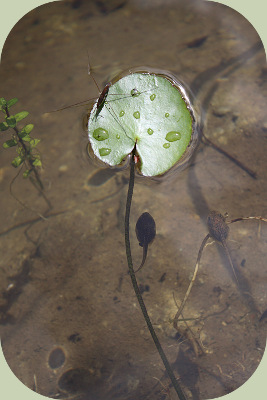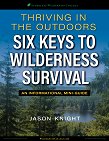Floating Pond Plants:
For Habitat, Food and Beauty

There are many wonderful uses for floating pond plants in your own pond setting. These plants can provide habitat for a wide variety of vertebrate and invertebrate animals, provide diversity and structure in your pond and be pleasing to the eye. I am defining floating plants here as both those that are not rooted and those with floating leaves that are rooted.
Why Floating Pond Plants?
Unlike emergent pond plants the floating pond plants, serve a completely different and yet necessary role in your pond. First, these plants provide habitat for many different creatures. Young fish may seek shelter under the cover of floating plants. Many small invertebrates such as insect larva spend much of their lives on, in or underneath the cover of floating plants. Some species of damselflies and dragonflies require plants such as water lilies to reproduce. They lay their eggs underneath the leaves, or even in the leaf stalks themselves. Floating plants help reduce water loss through evaporation when they cover a large fraction of the water's surface. Different floating plants can also be food for waterfowl, fish and mammals such as muskrats.
Pond Plant Ethics
Remember, when choosing a plant for your pond to practice good ethics and be a responsible steward. Don't introduce invasive species into your pond, especially if it is connected to other wetland areas! Please contact your local department of fish and wildlife for more information on invasive species in your area.
Be More Prepared For Your Next Outdoor Adventure!

Don't leave home without knowing these six essential survival skills. Our free survival mini guide reveals the strategies of:
- Shelter & fire to prevent the number one cause of death
- Obtaining clean water to avoid life-threatening dehydration
- Common wild survival foods and other critical skills!

What Species to Choose and Why?
There are a variety of species to choose from, but the following are some of the best, and includes water lilies and lotus though they are not free floating, but include floating parts. The text will list some of the benefits of each species.
- Western water lily, Cow-lily or Spatterdock (Nuphar polysepalum) = large leaves (up to 18” long) cover a lot of surface area, have edible seeds and roots, and beautiful yellow flowers. They provide cover for fish, amphibians and many invertebrate species.
- Fragrant water lily (Nymphaea odorata) = grows abundantly, covers a lot of surface area, flowers are beautiful and fragrant and cultivated varieties come in many colors, native of eastern USA. WARNING! This species is invasive on the west coast, and is even on the noxious weeds list in WA state.
- American lotus (Nelumbo lutea) = leaves can be up to 3 feet across, leaves can be used in cooking, large edible seeds, amazing wildlife food and habitat, large banana sized edible tubers, spectacular and mild scented flowers, grows in warmer parts of the USA.
- Fanwort (Cabomba caroliniana) = like a miniature water lily with floating leaves, but much of the foliage of this floating pond plant is underwater and very feathery and dense, provides habitat for many small insects and baby fish.
- Azolla or water ferns (Azolla sp.) = like miniature floating ferns, usually less than inch across, great food for ducks, can be skimmed off pond and fed to chickens. Be mindful that this plant can be invasive in some areas.
- Duckweed (Spirodela sp.) = tiny plants that look like single leaves with rootlets below, food for ducks, can be skimmed and fed to chickens, forms green mat. This plant can be invasive in some areas.
Closing Thoughts
Whether you have a tiny backyard pond or a large farm pond, floating pond plants can bring many benefits to your water body. They will add aesthetic value, improve wildlife habitat and can even provide food for you and your family.
By the way, a big part of why we love homesteading & permaculture skills so much is because they are a natural extension of learning about wilderness survival (both fields are all about self-sufficiency and working with nature to satisfy needs). An understanding of survival not only helps you become a better permaculturist, it empowers you with life-saving outdoor skills to keep you safe when out in nature. Right now you can get a free copy of our mini survival guide here, where you'll discover six key strategies for outdoor emergencies, plus often-overlooked survival tips.
Further Resources:
For additional information on pond plants, read our Plants for Ponds Article.
For more resources, check out the following links:
Water Garden Planting from BBC
Related Courses:
Permaculture Courses at Alderleaf

About the Author: Filip Tkaczyk is a periodic guest teacher at Alderleaf. He also wrote the field guide Tracks & Sign of Reptiles & Amphibians. Learn more about Filip Tkaczyk.
Return from Floating Pond Plants to Permaculture Articles
Is The Essential Wilderness Survival Skills Course Right for You? Take the "Online Survival Training Readiness" Quiz
See for yourself if this eye-opening course is a good fit for you. It takes just a few minutes! Get your Survival Training Readiness Score Now!

Grow Your Outdoor Skills! Get monthly updates on new wilderness skills, upcoming courses, and special opportunities. Join the free Alderleaf eNews and as a welcome gift you'll get a copy of our Mini Survival Guide.

 The Six Keys to Survival: Get a free copy of our survival mini-guide and monthly tips!
The Six Keys to Survival: Get a free copy of our survival mini-guide and monthly tips!
Learn more